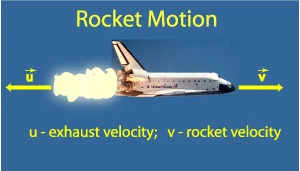Rocket Motion
In the given section we consider moving bodies with variable mass. Such kind of motion often occurs in nature and technology. We can mention here for example:
- Falling of an evaporating raindrop;
- Movement of a melting ice block or an iceberg on the ocean surface;
- Movement of a squid or jellyfish;
- Rocket flight.
Below we derive a simple differential equation for the motion of body with variable mass considering as an example rocket motion.
Differential Equation of Rocket Motion
Rocket motion is based on Newton's third law, which states that "for every action there is an equal and opposite reaction". Hot gases are exhausted through a nozzle of the rocket and produce the action force. The reaction force acting in the opposite direction is called the thrust force. The thrust force just causes the rocket acceleration.
Let the initial mass of the rocket be \(m\) and its initial velocity be \(v.\) In certain time \(dt,\) the mass of the rocket decreases by \(dm\) as a result of the fuel combustion. This leads the rocket velocity to be increased by \(dv.\) We apply the law of conservation of momentum to the system of the rocket and gas flow. At the initial moment the momentum of the system is equal to \(mv.\) In a small time \(dt\) the momentum of the rocket becomes
and the momentum of the exhaust gases in the Earth's coordinate system is
where \(u\) is the exhaust gas velocity with respect to the rocket. Here we took into account that the exhaust velocity is in the opposite direction to the rocket movement (Figure \(1\)). Therefore we have put the minus sign in front of \(u.\)

By the law of conservation of the total momentum of the system, we can write:
By transforming the given equation, we obtain:
We can neglect the term \(dmdv\) in the last expression considering small increments of these values. As a result, the equation is written as
We divide both sides by \(dt\) to convert the equation into the form of Newton's second law:
The given equation is called the differential equation of rocket motion. The right side of the equation represents the thrust force \(T:\)
As it can be seen from the last formula, the thrust force is proportional to the exhaust velocity and the fuel burn rate.
Of course, the differential equation we derived describes an ideal case. It does not take into account the gravitational force or aerodynamic force. Their inclusion leads to significant complication of the differential equation.
Ideal Rocket Equation or Tsiolkovsky Rocket Equation
If we integrate the differential equation, we can get the dependence of the rocket velocity on the burned fuel mass. The resulting formula is called the ideal rocket equation or Tsiolkovsky rocket equation who derived it in \(1897.\)
To get this formula it's convenient to use the differential equation in the form:
Separating the variables and integrating gives:
Take into account that \(dm\) denotes mass decrease. Therefore we take the increment \(dm\) with the negative sign. As a result, the equation is written as follows:
where \({v_0}\) and \({v_1}\) are the initial and final velocities of the rocket, \({m_0}\) and \({m_1}\) are the initial and final masses of the rocket, respectively.
By setting \({v_0} = 0,\) we obtain the formula derived by Tsiolkovsky:
This formula determines the rocket velocity depending on its mass change while the fuel is burning. It allows rough estimation of the fuel capacity necessary to accelerate the rocket to a given velocity.